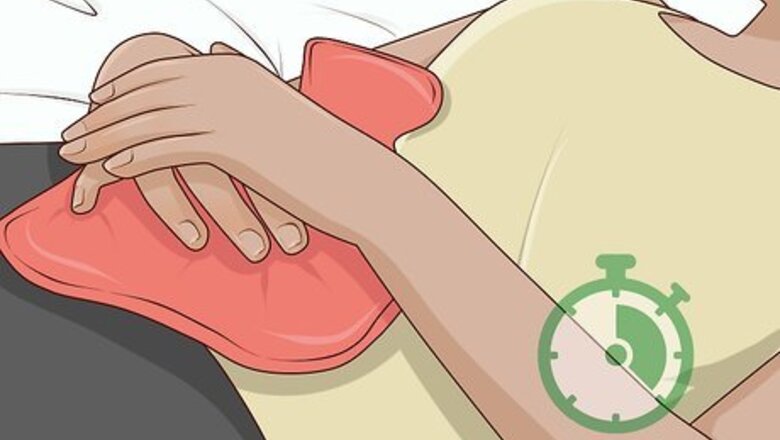
views
Easing Pain and Winding Down at Night
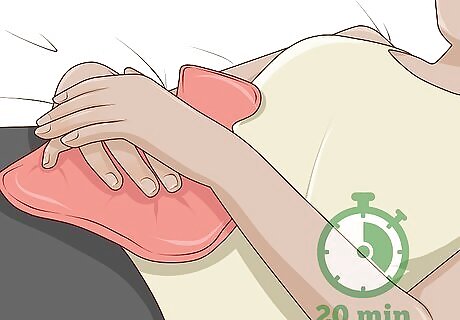
Apply a heating pad to your lower abdomen for 20 minutes before bed. Set a heating pad to medium or low heat and place it on your lower belly for 20 minutes before you go to sleep. You can even sleep with it on your stomach if you like, just be sure to set it to low so you don't get too hot. Heat helps relax your muscles, easing painful cramps so you can sleep pain-free. If your heating pad has a timer or automatic "off" feature, use that so it'll go off after an hour or two. That way, you won’t wake up in a sweat. If you don't have a heating pad, you can also put a small, damp towel in the microwave for 30 to 60 seconds and lay it over your stomach. Just make sure it’s not too hot so you don’t burn your skin. If it is, fan it out for 1 minute.
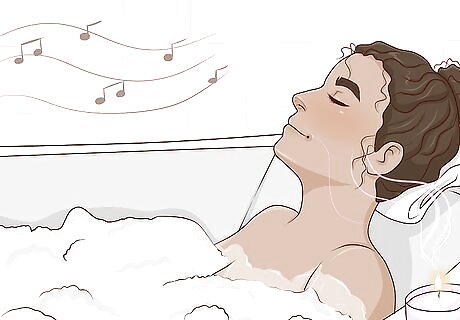
Soak in a hot bath or take a hot shower before going to bed. Wind down with a hot, comforting soak or shower about 30 minutes before going to bed. The heat will help your entire body relax, including the temporarily-finicky muscles in your abdomen. Light some scented candles and listen to calming music while you're soaking to soothe your body and mind. Consider adding 2 cups (256 grams) of Epsom salt or bath salts to the water to relieve tension and cramps.
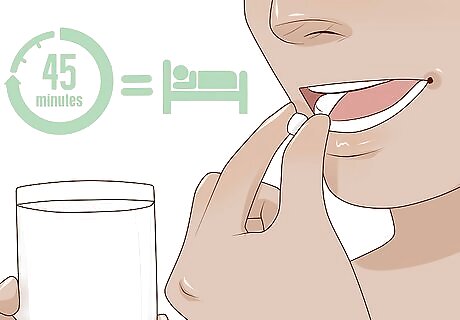
Take OTC pain medication 45 minutes before going to bed. Swallow 2 capsules of ibuprofen or acetaminophen with 8 fluid ounces (240 mL) of water about 45 minutes before you lie down to go to bed. If your cramps are mild, you can probably just take 1 to get you through the night. Always follow the dosing directions and heed the listed warnings on the package. Don’t take OTC pain medicine if you take blood thinners—talk to your doctor about alternatives.

Massage your lower abdomen and lower back at night. Slather a dime-sized amount of lotion between your hands and give your belly and back a relaxing massage. To massage your belly, apply light to medium pressure to massage your belly in circular or kneading motions. For your back, place your hands behind you and use your thumbs to apply pressure to the area just above your butt and around your lower spine. You can also place a tennis ball between your back and a wall and shift your positioning to break up knots and massage hard-to-reach spots. Use a scented lotion containing lavender to help calm yourself into sleep.
Stretching Before Bed

Perform a wide-leg forward bend to stretch your lower back and legs. From a standing position, spread your legs wider than hip-width apart and bend your torso down to the ground. Hold the stretch for at least 30 seconds before relaxing back into a standing position. Stretching your hamstrings and lumbar spine can help loosen up any tight or achy muscles that may be giving you trouble during your period.
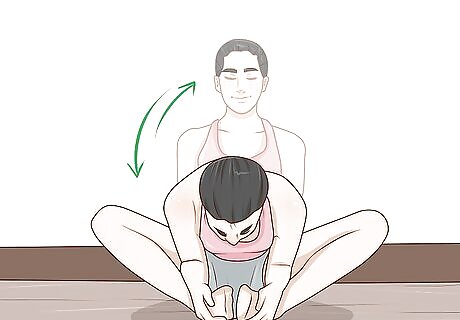
Try the seated butterfly stretch to relax your pelvis and hip muscles. Sit down with your legs open and your knees bent, the soles of your feet touching. Press your feet together as you lower your chest towards your toes. Breathe in and out at least 5 times to help you relax into the stretch. You can also place your hands on your knees and push down while you’re sitting upright to stretch your inner hip and thigh abductors. After the stretch, try flapping your knees up and down like butterfly wings to loosen up your pelvis muscles even more. For a deeper stretch while you’re leaning over, use your elbows to push your knees toward the floor.
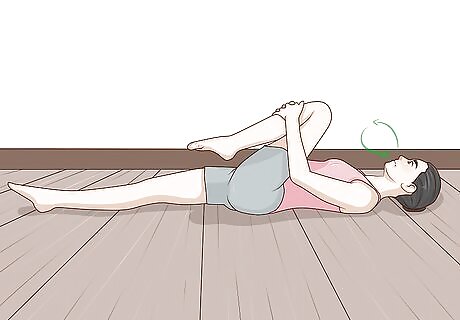
Relieve bloating and muscle spasms by doing a horizontal single-leg stretch. Lie down flat on your back and grab one knee with your hands and pull it in towards your chest. Hold the stretch for 8 counts or 5 long breaths before releasing your leg back to the floor. Do the same thing with the other leg. You can do this stretch as many times as you like. This move will help relieve excessive bloating and pain or spasms in your lower back.
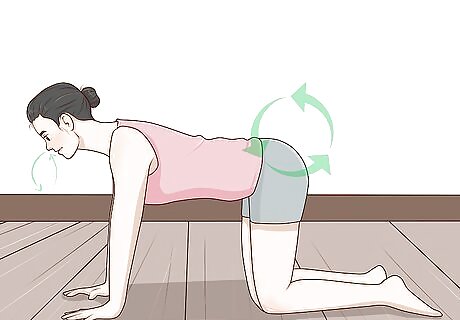
Rotate your pelvis while on your hands and knees to ease cramps. Start with your hands placed directly under your shoulders and your knees on the ground right under your hips. Slowly breathe in and out as you rotate your hips and pelvis in a circular motion. Do 5 to 10 clockwise circles followed by 5 to 8 counter-clockwise rotations. Your back should slightly rise up and down as you rotate your hips. Go slow and try to coordinate your breathe with your movements (that is, inhaling when your pelvis is tilted upwards and exhaling when your pelvis is tucked in and your back is arched).
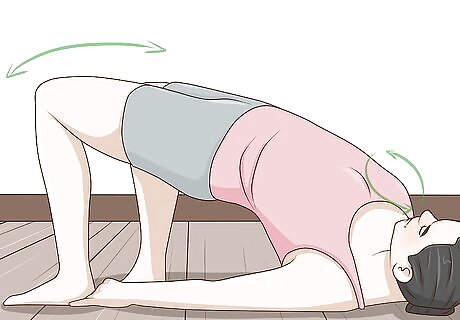
Do horizontal hip-twists to ease bloating and cramps. Lie flat on your back with your knees bent and your feet planted on the ground (as if you’re going to do a bridge). Let your arms relax perpendicular to your torso. Inhale and as you exhale, slowly move your knees to one side as far as you can go. Inhale once you come back to the center and repeat the movement on the other side. The soles of your feet will come off the ground as you twist. Don’t focus on pushing your knees toward the ground. Be gentle with yourself; go as far as you can and stop if you feel any discomfort.
Altering Your Diet
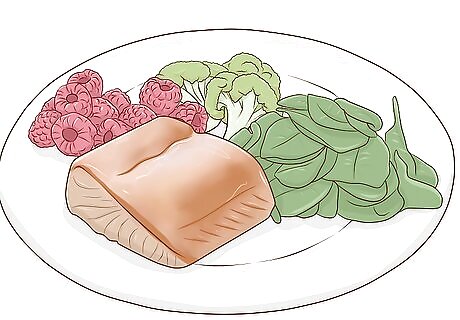
Try to get 310 to 320 mg of magnesium every day. Green leafy vegetables (like kale and spinach), bananas, raspberries, legumes, cruciferous vegetables (like broccoli, Brussels sprouts, and cabbage), and fish (like salmon, mackerel, and tuna) are all good things to eat before and during your period to keep cramping to a minimum. If you're worried you're not getting enough from your diet alone, talk to your doctor about taking a magnesium supplement. It’s easy to get magnesium from eating greens at every meal—just one cup of spinach contains 157 mg. Too much can cause diarrhea, so avoid going overboard with magnesium in an effort to ease your cramps.
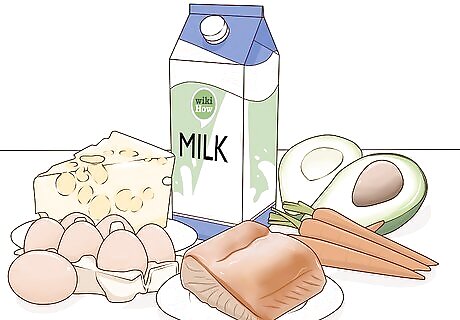
Take in 1.3 to 1.7 mg of vitamin B6 every day. Make an effort to amp up your B6 intake before and during your period to alleviate cramps and bloating. As a plus, B6 allows your brain to release serotonin and dopamine, which can help beat the blues and prevent menstrual migraines. Animal-based sources of B6 include milk, cheese, salmon, tuna, eggs, chicken liver, and beef. Spinach, sweet potatoes, carrots, green peas, chickpeas, bananas, and avocado are great plant-based sources of B6.
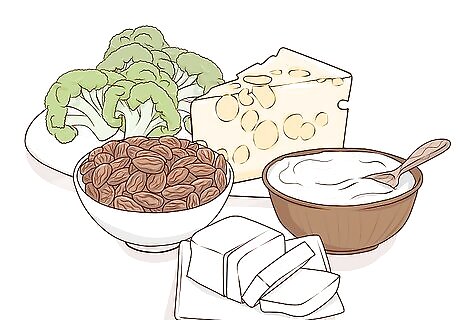
Make sure you’re getting around 500 mg of calcium per day. Eat something rich in calcium at every meal or snack during your period to help alleviate cramps and muscle pain. Calcium helps regulate your hormones, which is helpful since menstrual pain is linked with fluctuating hormones during that time. Almonds, chia seeds, broccoli, kale, collards, cheese, yogurt, beans, tofu, and fortified cereals are all great sources of calcium.
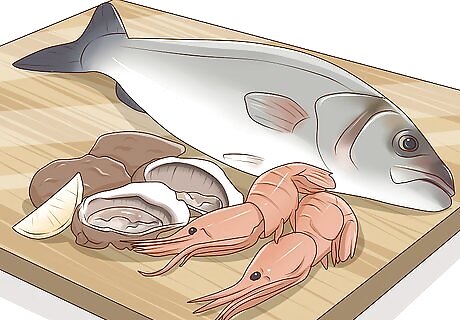
Incorporate foods with omega 3 fatty acids into each meal. If you eat fish, mackerel, salmon, seabass, oysters, sardines, shrimp, and trout are all loaded with omega 3 fatty acids. Enjoy one of these varieties for lunch or dinner or put them on top of a salad or whole grains. If you're vegetarian or vegan, you can get omega-3 from walnuts, flaxseeds, chia seeds, hemp seeds, seaweed, algae, winter squash, edamame, and kidney beans. Consider taking a fish oil supplement if your doctor says it's okay.
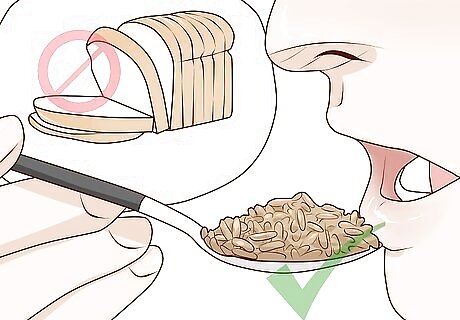
Swap refined grains for whole grains at lunch and dinner. Avoid eating white rice, white pasta, and white bread while you’re on your period because they can increase any bloating and make it hard for you to get comfortable at night. The high-quality fiber in whole grains can help ease any inflammation that causes uncomfortable bloating and cramps. Brown rice, black rice, wild rice, quinoa, bulgar, barley, oats, and sorghum are all great alternatives to fill you up.
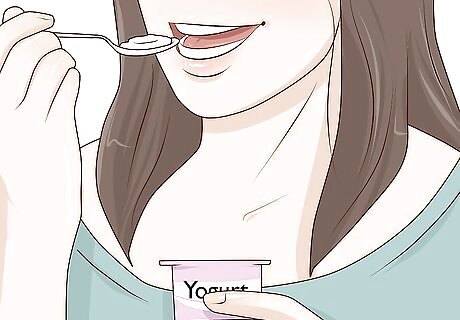
Ditch late-night treats like cookies and commercially-prepared snacks. Avoid eating processed foods like crackers and cookies after dinner or as a bedtime snack. The trans-fatty acids found in these foods can irritate your stomach and add to any late-night cramps and bloating. Yogurt and fruit and good pre-bedtime snack options. The probiotics and antioxidants will help soothe your tummy and ease cramps.
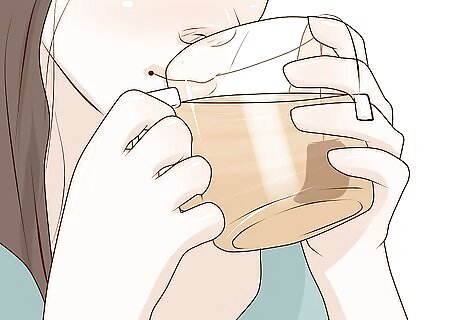
Sip on chamomile, fennel, or ginger tea before bed. Pour 8 fluid ounces (240 mL) of boiling (or near-boiling) water over a tea bag and let it steep for 3 to 5 minutes. These teas contain anti-inflammatory compounds that have been shown to soothe menstrual cramps and muscle spasms, helping you get better sleep at night. Squeeze a lemon wedge into your tea for extra protection against nausea and bloating.
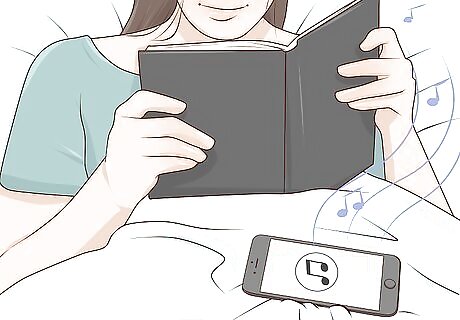
Don't smoke or drink alcohol within 2 to 3 hours of going to bed. When you’re winding down for sleep, resist the urge to have a nightcap or, if you smoke, a cigarette. Alcohol and tobacco increase inflammation in your body, which can make any existing cramping and bloating much worse. Figure out something else to do instead of having a drink or a smoke. Reading, stretching, or listening to calming music are much healthier bedtime rituals to bring on restful sleep.















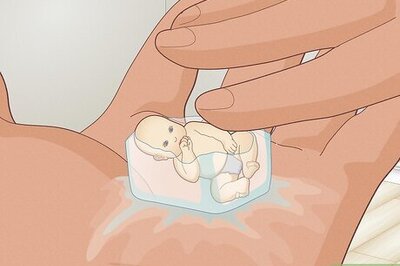

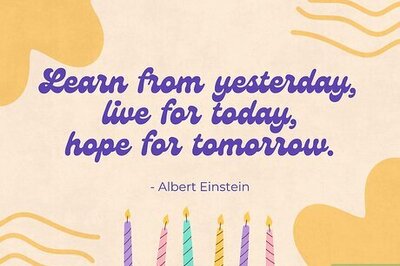
Comments
0 comment